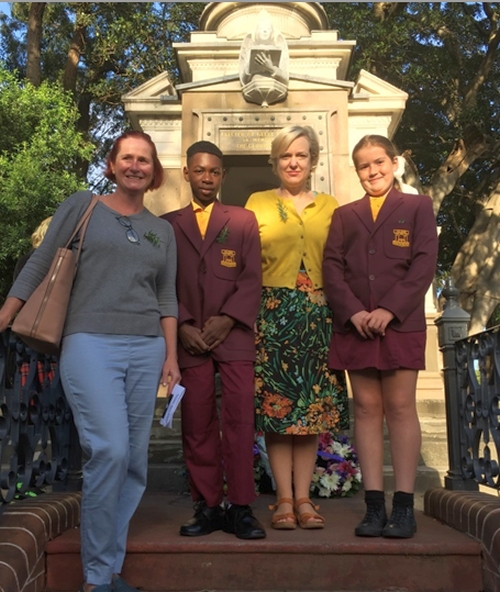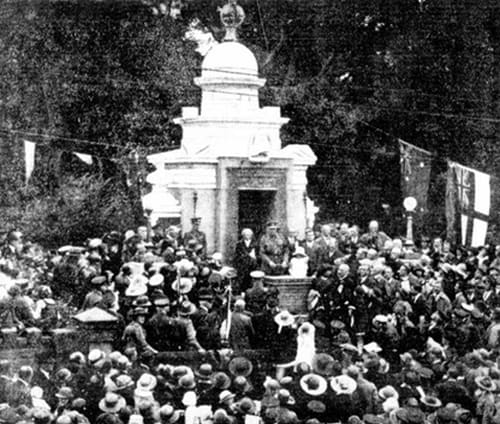Glebe Public school took part in the 2019 Anzac Day service held at Glebe War Memorial. Many attending commented on the presence of the school leaders, Georgina and Justodio, as they handed out sprigs of rosemary to people gathered and then laid flowers at the Memorial. Also in attendance was Glebe Society President Verity Firth, and Linda Scott, Deputy Lord Mayor.
The service was led by Fr Dominic Murphy, parish priest St James Glebe. Max Solling provided a moving address on reflections from those who served and special memorial services held by local women to remember their lost loved ones. Max’s address is reproduced below.
Morning tea (include homemade Anzac biscuits) was served in St John’s Church afterwards.

Max Solling’s Anzac Day 2019 address
This morning I would like to share some thoughts on World War I and its aftermath. On 11 November 1918 the bells rang out from St John’s Bishopthorpe Glebe signalling the end of four years of trial and tragedy. Remembrance or Armistice Day is a solemn acknowledgement of the tragic loss of around 8 million lives. The British imperial dead numbered over a million and sending bodies home was logistically impossible.
Among the most powerful novels and memoirs published after the war was Erich Remarque’s All Quiet on the Western Front. A story of a young German soldier conscripted at the age of 18, wounded several times, and living through the terror of war and the alienation he feels at the prospect of returning home afterward. Remarque recounted his aim in writing the novel was ‘simply to tell of a generation of men who, even though they may have escaped shells, were destroyed by the war’. War, in his view, had obliterated almost a generation of men. The novel’s extraordinary appeal may stem from the author’s success in universalising the soldiers’ experience — that the war was the same for all who fought. This war did not end all wars but simply set the pattern for new and even more mechanised killing. Each chapter ends on a significant point or with a summarising observation, and the brief but highly important concluding chapter. It is still in print by Vintage Books.
Writing letters and keeping diaries were a way AIF soldiers could manage and cope with the chaos that surrounded them at the front. Among the local citizen soldiers to enlist were the Neaves brothers, products of Glebe Public School. Erle, a cashier, wrote to brother Harry, a grocer, that ‘all my pals … I came over with are gone … it’s simply scientific murder, not war at all. I keep smiling but I tell you it takes some doing … the premonition I had when leaving Sydney that I will never see home again still hangs about me’. Both Harry and Erle died in France.
Six months before the war ended, a new and more deadly scourge was unleashed. The devastating Spanish flu epidemic killed 30 million people worldwide. There was a fear that the 167,000 Australian servicemen returning home from Europe might allow infection to spread to Australia. The logistics of transporting these men was formidable but delay caused by a shortage of shipping and an effective quarantine system avoided the worst effects of the virulent virus with only 12,000 fatalities in Australia. The public health crisis added to the challenge of integrating thousands of veterans back into Australian society.
Peace brought its own challenges. The optimism and social experimentation that characterised the decade after Federation; especially arbitration and the basic wage system, came increasingly under scrutiny in the 1920s as the economy faltered. The immediate post-war years brought a vastly different mood, with the impact of war weakening the social fabric of society.
The families of men killed on foreign battlefields were deprived of the traditional mourning ritual of their culture. Their dead lay far away. Losing so many young men on the other side of the world without any possibility of a funeral, left an aching void in their lives. The distinctiveness of the Australian response to the horrors of World War I is evident in the proliferation of memorials across Australia’s urban and rural landscapes; 1,445 in altogether, recorded in Ken Inglis and Jan Barzier’s rich cultural history, Sacred Places: War Memorials in the Australian Landscape (1998).
In Glebe Mayor Finlay Munro called a meeting at Glebe Town Hall on 3 April 1919 about creating a memorial, a collective resting place for all its residents who were killed in action or died of wounds. It would be a tangible presence for local mourners separated from their dead at Gallipoli, France and the Middle East. Sites at the fountain reserve near Broadway, and the corner of St Johns Rd and Derwent St were considered but a more conspicuous site within the grounds of Hereford House fronting Glebe Point Rd was chosen. The Department of Education agreed to transfer the land in March 1921, a time when Glebe’s population was counted as 22,754 at the census.
Funded and erected by Glebe residents for £2,500, architect and Glebe councillor William Martin’s design of the Glebe granite and marble mausoleum unveiled on Anzac Day 1922 is a very Australian monument. Neither the Empire nor Britain are represented; the inscriptions are simple and understated: ‘Erected by Glebe Residents in Memory of the Glorious Dead’.
During the 1920s services at this memorial were conducted by a combination of Protestant clergymen, Salvation Amy chaplains and City Mission lay preachers, the Glebe Boy Scouts and Girl Guides forming a guard of honour, with the Glebe Brass Band playing the Dead Soul March and the Last Post.
Unveiling day in 1922 was a time for spectacle and music as well as words. A particularly poignant, intimate occasion charged with high emotion and great solemnity took place here on Anzac Day 1923 when the women of Glebe grasped their opportunity to collectively express their sense of profound loss, a number of families losing more than one member. It took the form of a pilgrimage, and grieving mothers, widows and sisters, all dressed in black and wearing hats, who turned up en masse together with other grief-stricken local people, all crushed together around the monument.
Bill Brown, secretary of the memorial committee, then proceeded to read out the name of each soldier inscribed in gold on the marble nameplate, and, as he did, a Glebe woman stepped forward to lay a wreath for their son or husband. To these women the monument was more than a public statement of grief and pride. It was a hallowed place that the bereaved might visit on anniversaries of death or birth. On these intensely personal occasions passing pedestrians had seen women standing in front of the granite and marble mausoleum, head bowed in quiet contemplation. They could not see their faces. They did not want to. In these moments it was felt there were some things better left to the imagination.
War had thrown men into the older world masculine camaraderie and the return to civilian life meant an abandonment of the supportive embrace for the lonely challenge of the breadwinner. They returned from the war drained of idealism. The promise that they would be rewarded with homes ‘fit for heroes’ had a hollow ring in Glebe’s oldest neighbourhoods where the Glebe Ratepayers and Property Owners Association declared many dwellings ‘not fit for pigs to live in’.
The First World War’s most profound influence on Australian popular culture came through the many expressions of the Anzac legend which produced a rich mix of beliefs, ideas, stories and practices that – a century on – retain a powerful hold on Australian life.











One comment. Please add yours.
Thank you Max Solling for all the hard work you have put in over the years to keep the Anzac day going in Glebe , it is great to see that the school children are now involved . It was Max who inspired me ( after leaving Glebe and moving to Pyrmont in 1990 ) to get the Anzac service started in Pyrmont in the early 1990s with the new Uniting church in ultimo now called the Mustard Seed Uniting church . Each year these events get bigger and bigger , they bring people together , this is what community is all about . Once again , thank you Max for all the great work you have done over the years for your beloved Glebe . Carole Twist